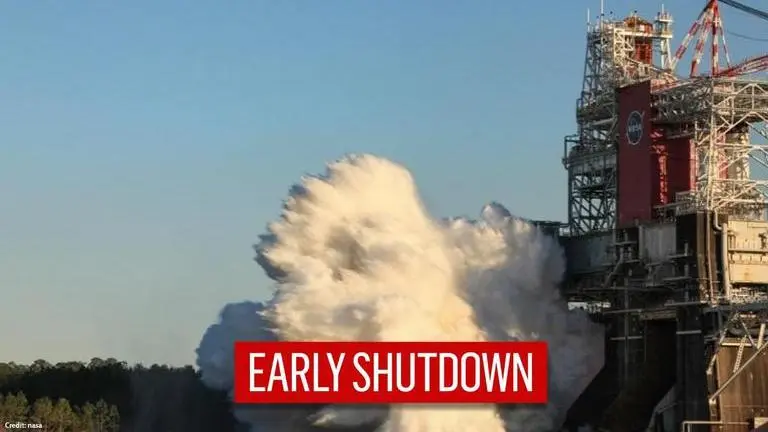Updated 17 January 2021 at 12:47 IST
Crucial engine test for NASA's Space Launch System rocket cuts short
NASA ignited engines at Stennis Space Center in Mississippi at 4:27 pm local time (22:27 GMT) and the test finished little more than one minute into 'hot fire'.
- World News
- 3 min read

NASA’s Space Launch System, or SLS rocket’s ‘hot fire’ the final test of the Green Run series on January 16 ended with an early shutdown. The test plan had called for the giant moon rocket’s four RS-25 engines to fire for a little more than eight minutes. However, as NASA ignited the engines at Stennis Space Center in Mississippi at 4:27 pm local time (22:27 GMT), the test finished a little more than one minute into the hot fire. After the SLS’s 212-foot (65-meter) tall core stage was aborted earlier, a team assessing the data said in a release that it will determine the cause and draft a path forward.
Watch all four @NASA_SLS core stage engines roar to life and shake the ground in Mississippi.
— NASA (@NASA) January 16, 2021
Teams are assessing the data on early engine shutdown. pic.twitter.com/U5bNqqbdZd
Today, @NASA, @BoeingSpace, and @AerojetRdyne held the Green Run hot fire test.
— NASA HQ PHOTO (@nasahqphoto) January 17, 2021
Take a look at the imagery we captured of all four RS-25 engines of @NASA_SLS firing simultaneously at @NASAStennis. 📷 https://t.co/Usl68VINOW pic.twitter.com/vAlTSFp0kH
As the SLS generated 1.6 million pounds of thrust while anchored in the B-2 Test Stand, with at least 733,000 pounds of liquid oxygen and liquid hydrogen loaded on the rocket, the engines ignited and engineers spotted a flash near engine four, around the thermal protection blanket. A few seconds later, the rocket had a total shutdown. NASA said in a statement, "At this point, the test was fully automated. During the firing, the onboard software acted appropriately and initiated a safe shutdown of the engines". John Shannon, the SLS program manager at Boeing, said at a press conference, "[If] we had an early shutdown, for whatever reason, we get all of the engineering data we need to have high confidence in the vehicle at about 250 seconds". However, the NASA team could manage data far lesser than 250 seconds.
Advertisement
[Credits: NASA Television]
[Credits: NASA Television]
"Saturday’s test was an important step forward to ensure that the core stage of the SLS rocket is ready for the Artemis I mission, and to carry crew on future missions,” said NASA Administrator Jim Bridenstine, who attended the test. “Although the engines did not fire for the full duration, the team successfully worked through the countdown, ignited the engines, and gained valuable data to inform our path forward.”
Landing astronauts on Moon in 2024
NASA Administrator Jim Bridenstine said at a press conference after the event, "not everything went according to script today". NASA’s hot fire for the SLS was aimed at the future launch out of Cape Canaveral known as Artemis I which would send NASA’s astronauts onboard Orion spacecraft on the lunar surface. NASA’s Green Run series of tests for SLS began in January 2020, when the stage was delivered from NASA’s Michoud Assembly Facility in New Orleans and installed in the B-2 test stand at Stennis. Now, the team will inspect the core stage and its four RS-25 engines before determining the next steps. "Under the Artemis program, NASA is working to land the first woman and the next man on the Moon in 2024", the space agency said.
Well MCF was not a call this ascent flight director ever wanted to hear: Major Component Failure is detected by the SSME controller.
— Wayne Hale (@waynehale) January 16, 2021
Well shucks. Turns out I missed what should have been a spectacular ISS pass over Houston because I was listening to the press conference about the hot fire test.
— Wayne Hale (@waynehale) January 17, 2021
Advertisement
Published By : Zaini Majeed
Published On: 17 January 2021 at 12:47 IST


